
On a clear night, an individual can observe approximately two to three thousand stars in the nighttime sky with their unaided eyes. However, these stars appear so similar that distinguishing between them can be challenging. This video lesson provides insights into the names of constellations and the origins of their names. It also delves into the concept of stellar magnitude and how the Hipparchus scale of stellar magnitudes is constructed. Additionally, the lesson covers Bayer’s system of classifying stars.

At the moment, you are unable to view or distribute the instructional video to your students
In order to gain access to this and the rest of the video lessons included in the package, you will need to add it to your personal account.
Unlock amazing functionalities


Stars and Constellations Lesson Plan
On a cloudless night, the sky is filled with an abundance of stars, creating a breathtaking view. It can be overwhelming to comprehend the vastness of this celestial display. The words of the renowned Russian scientist and poet, Mikhail Vasilyevich Lomonosov, echo in my mind:
The abyss is teeming with stars,
The stars are countless, the abyss is immeasurable.
While there are approximately 2-3 thousand stars visible to the naked eye on a clear night, they all appear so similar that distinguishing between them becomes a challenge.
Ancient Egyptian astronomers sought a solution to this dilemma. They devised a method to navigate the vast expanse of the night sky by grouping certain stars together and connecting them with imaginary lines, thus creating what we now know as constellations.

This particular activity proved to be extremely practical as it occurred in a time when the compass had not yet been developed. Therefore, people relied on the stars as their guiding reference points during the night. In his renowned work, “The Great Mathematical Construction of Astronomy in 13 Books,” the Greek astronomer Claudius Ptolemy mentions a total of 48 constellations. Some noteworthy ones include the Big Dipper, Little Dipper, Orion, Hercules, Scorpius, and many more.
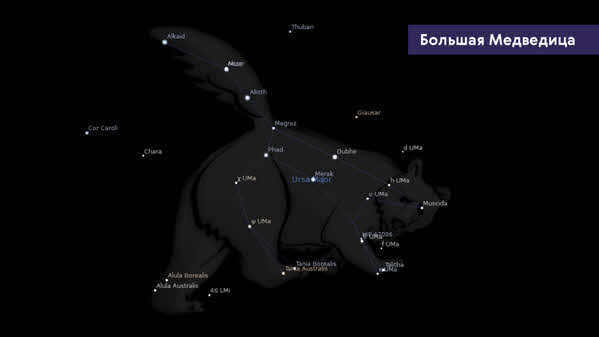
Many constellations have names that might seem strange because they are difficult to visualize as animate beings. For instance, some people have trouble seeing the Big Dipper as a star bucket. Yet, the Big Dipper is one of the largest and most recognizable constellations, consisting of 210 stars that can be seen with the naked eye.
Many of the most well-known constellations have names derived from different cultures. For example, the ancient Slavs depicted the Big Dipper as an Elk or a Deer.
Around the 3rd century B.C., ancient Greek astronomers unified the names of all the constellations known to them into a single system that was closely tied to their mythology. These names were later adopted by European science.
Regarding the Southern Hemisphere, the names of its constellations were given during the period of the great geographical discoveries, when Europeans commenced their exploration of the New World.
However, in astronomy, a complex situation arose over time. Up until the 19th century, constellations were understood worldwide as not just areas of the sky, but rather specific groups of stars, often overlapping with each other. It was discovered that certain stars belonged to two constellations simultaneously, while some star-deficient regions did not belong to any constellation at all. Therefore, at the beginning of the 19th century, boundaries were drawn between constellations on the celestial sphere to eliminate the “gaps” between them. Yet, this did not resolve the issue entirely, as there was still no clear definition of constellations, and different astronomers defined them in their own unique ways.
In 1922, during the General Assembly of the International Astronomical Union in Rome, a total of 88 constellations were officially approved. It was not until 1928 that clear and unambiguous boundaries were established between these constellations. It was also agreed upon by astronomers that these boundaries and names would never be altered again.
As a result, in present times, constellations are specific regions of the night sky that have distinct boundaries and contain recognizable groupings of stars.
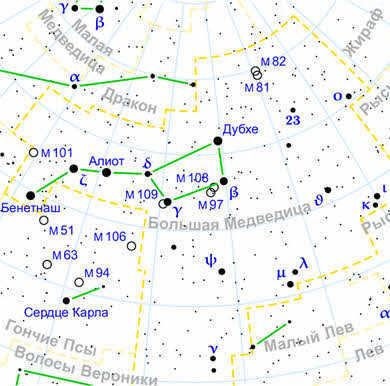
As mentioned previously, the night sky reveals a multitude of stars that can be observed with the naked eye. These stars vary in their brightness, with some shining brightly while others are more difficult to detect. This led to the classification system established by Hipparchus of Nicaea, a renowned astronomer of the 2nd century B.C. He categorized all stars into six different magnitudes based on their brilliance. The first magnitude was reserved for the brightest stars, while the sixth magnitude was assigned to the least visible stars. The remaining stars were evenly distributed among the intermediate magnitudes.
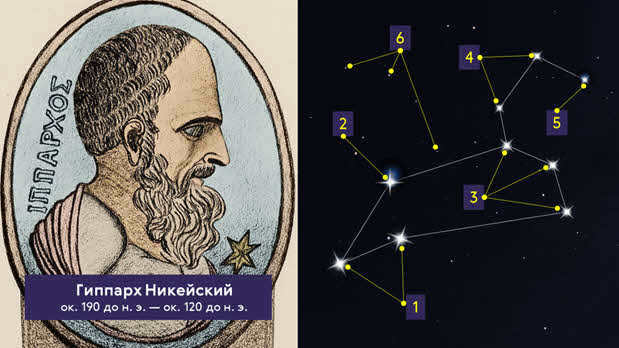
The system of stellar magnitudes continues to be widely employed in modern times. The magnitudes of stars are indicated by the symbol m (derived from the Latin term ‘magnitude’), which is positioned above the numerical value.
Furthermore, ancient Greek and Arabic astronomers assigned individual names to approximately 300 of the most brilliant or intriguing stars, including Vega, Sirius, Rigel, Aldebaran, and others.
In 1603, the German astronomer Johann Bayer introduced his own system for star nomenclature, which remains in use today. This system involves a star’s name being composed of two components: the name of the constellation it belongs to and a letter from the Greek alphabet. Typically, the letter designation is given based on the star’s decreasing brightness within the constellation.
As an illustration, the most brilliant star in our celestial sphere, Sirius, is designated on charts as α of the Canis Major, and Polaris is α of the Ursa Minor.
Remarkably missing from this roster is the star formation of the Ursa Major, whose seven luminous stars shape the renowned Great Ladle. The classification of these stars was merely from east to west.
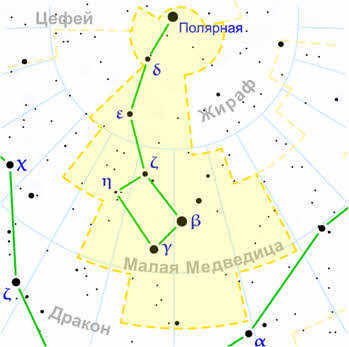
Therefore, the furthest star of the Dipper, Dubhe, is referred to as the α of the Ursa Major, despite being less bright than Aliot, the ε of the Ursa Major. And the third brightest star in this constellation, Benetnash, is commonly designated by the letter η.
As science advanced and telescopes were invented, the number of stars being studied increased. Naturally, the Greek letters were no longer sufficient for their identification. It was then proposed to use letters from the Latin alphabet. When those also ran out, stars started to be labeled with numbers (for example, the star 44 Volopassus).
Over time, it became apparent that the estimations of stellar magnitudes provided by Hipparchus for over a hundred stars were quite rough. Specifically, it was revealed that our eyes respond to the energy of light that passes through the pupil. Yet regardless of the size of the pupil, its luminosity (which is, the flow of radiation that emanates from the light source to the observer per unit time per unit area perpendicular to the line of sight). Consequently, stellar magnitude can be seen as a measurement of the brightness produced by the observed source. In modern astronomy, the term luminosity is now utilized.

After the invention of photometers in the 19th century, a whole new era began in the study of star brightness. These instruments allowed scientists to measure the luminosity of stars and their systems. It was discovered that a difference of five stellar magnitudes on the Hipparchus scale corresponds to a luminosity ratio of about 1:100. This finding led to the creation of a new scale where this ratio would be exactly 1:100. Thus, a difference of one stellar magnitude signifies a luminosity ratio between stars.
In simple terms, a first magnitude star has a luminosity that is 2.512 times greater than a second magnitude star. Similarly, a second magnitude star has a luminosity that is 2.512 times greater than a third magnitude star, and so on.
Norman Robert Pogson, an English astronomer, suggested a formalization of the scale of stellar magnitudes that was later widely adopted, following this model.

By applying Pogson’s relation, we can not only determine the magnitudes of dim stars, but also those of objects brighter than the first magnitude. This means that several stars in the sky have been classified as having a magnitude of zero. For instance, the brightest star in the entire sky, Sirius, has a negative stellar magnitude of -1.5 m.
Let’s also attempt to calculate how many times the Moon’s brightness during a full moon exceeds its brightness during the first quarter phase.
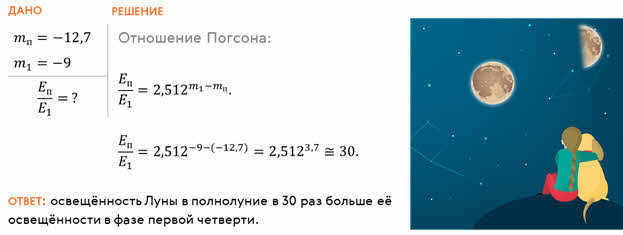
The determination of the Sun’s stellar magnitude was carried out in 1903 by Vitold Karlovich Tserasky, a Russian astronomer hailing from the town of Slutsk, Minsk province (now the Republic of Belarus). According to Tserasky’s findings, the magnitude of the Sun is -26.72 m, a value that deviates only slightly by 0.02 m from the modern measurement.
With the advent of the telescope, scientists gained the ability to observe fainter stars, which emit significantly less light compared to sixth magnitude stars. As telescope technology advanced, the scale of stellar magnitudes expanded further and further. A notable example is the Hubble Space Telescope’s capture of an object with a stellar magnitude of 31.5 m.
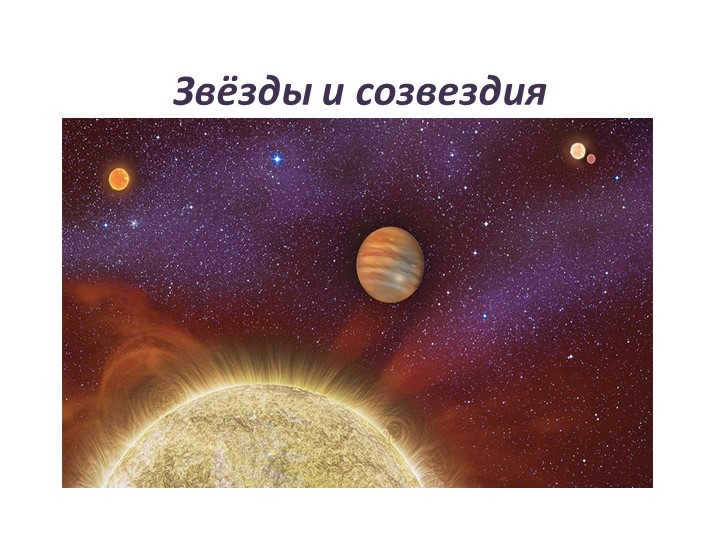
On the second slide, Sergei Yesenin wrote, “Clear stars, high stars! What do you keep in yourselves, what do you hide?” This inquiry has been pondered by humanity for centuries, not just by poets, but also by scientists. It is worth noting that numerous enigmas of the stars have already been unraveled.

Slide 3: What exactly is a star?
A star is a stationary celestial object that resembles a luminous sphere.
Stars release energy, resulting in the emission of light.
There are various types of stars, including giant stars, supergiant stars, and dwarf stars.

Slide 4: Star Color and Temperature
Contrary to their various hues, stars can be categorized into three primary colors: red, yellow, and blue.
The coloration of a star is directly related to its temperature.
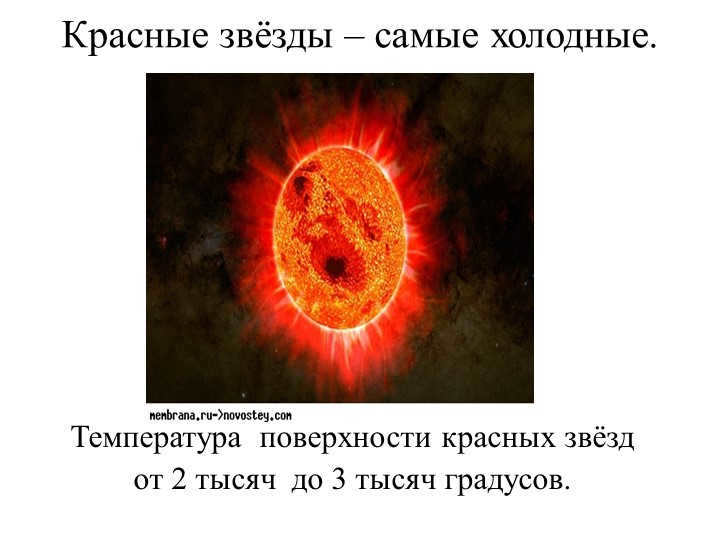
Red stars that have a temperature between 2,000 and 3,000 degrees Celsius are known to be the coldest stars.
The surface temperature of these stars is classified as being very low.
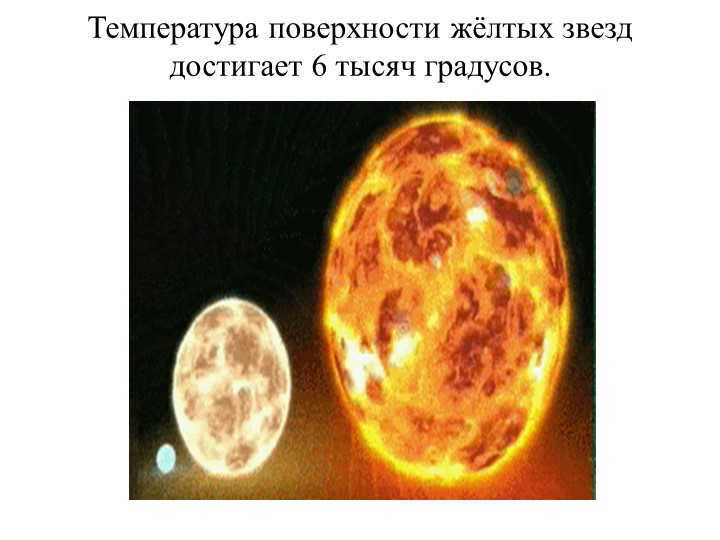
Yellow stars can reach surface temperatures of up to 6 thousand degrees.
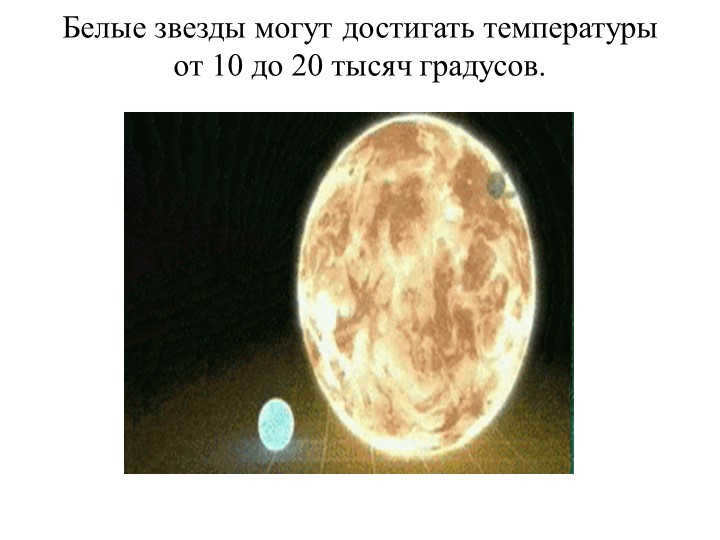
The temperature of white stars can range from 10 to 20 thousand degrees, as stated in the seventh slide.

Slide number 8 is dedicated to the most sizzling celestial bodies known as blue stars.
Blue stars, with their scorching surface temperatures ranging from 10,000 to 100,000 degrees, are truly a sight to behold.


Stars have a finite lifespan, at the end of which they will cease to exist.
The Sun, a yellow star, was formed approximately 4.6 billion years ago and is currently halfway through its existence. Over time, it will undergo a transformation into a red giant before eventually becoming a white dwarf and ultimately ending up as a black dwarf.


On slide 10, we learn about Beta Centauri, which is the second brightest star. Unlike Alpha Centauri, Beta Centauri is not a neighbor and is located much farther away. However, it still shines brightly. This is because Beta Centauri is a different type of star. Alpha Centauri, on the other hand, is one of the brightest stars due to its close proximity to us.

slide 11 What is a constellation.
A constellation is a group of stars.
Presently, researchers indicate that there are presently
88 such groups.
There are big groups and small groups of stars.
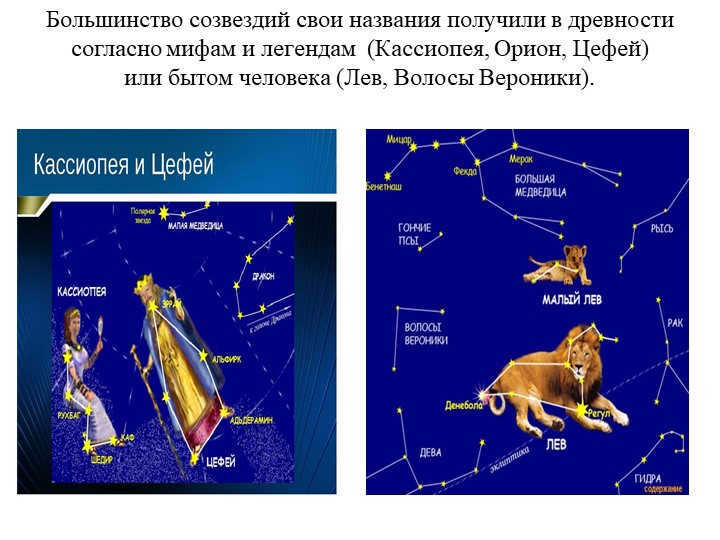
Slide 12 The majority of constellations were named in ancient times based on myths and legends (such as Cassiopeia, Orion, and Cepheus), or aspects of human existence (like Leo and Veronica’s Hair).
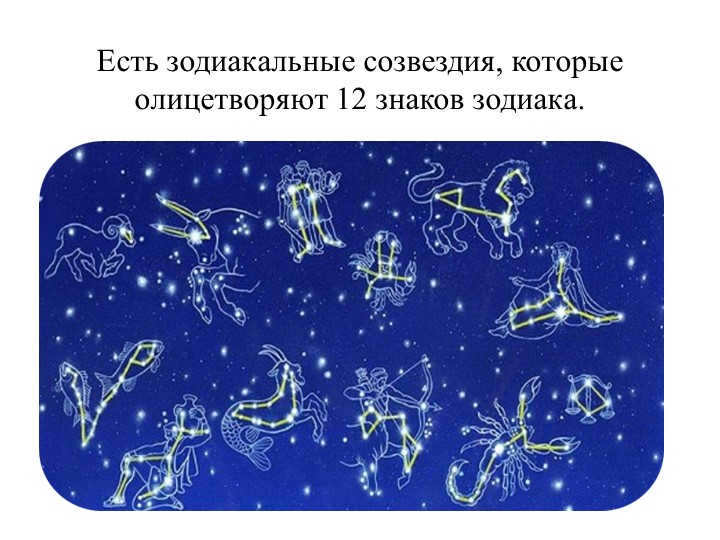
Slide 14 The Big Dipper – A Cluster of Stars
The Big Dipper, one of the largest constellations, has a distinct shape resembling a dipper. This constellation consists of 125 stars, although it appears to consist of only 7. Adjacent to the Big Dipper is the Little Dipper, widely recognized as Polaris.


Slide 15: The constellation Orion is renowned for being one of the largest constellations, and its name is steeped in legend as it represents the mythical hunter Orion.
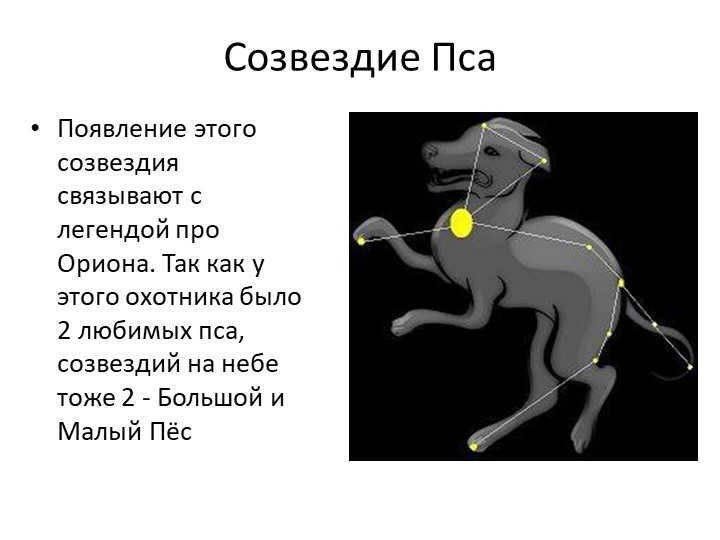
Slide 16: The Dog constellation
The Dog constellation is linked to the myth of Orion, who was known for his two beloved hunting dogs. As a tribute to their loyalty, two constellations were formed in the night sky – the Big Dog and the Little Dog.


Slide 17: The starry sky is full of diversity, with insufficient time to unveil all the secrets held by the stars.
However, we do have the ability to learn about the mysteries that have already been revealed through books, encyclopedias, and movies.
Discover the wonders of the Stars Magazine,
Explore the World X: Secrets of Space – Stars and Constellations.
Experience the captivating videos that delve into the enigmas of stars and constellations.
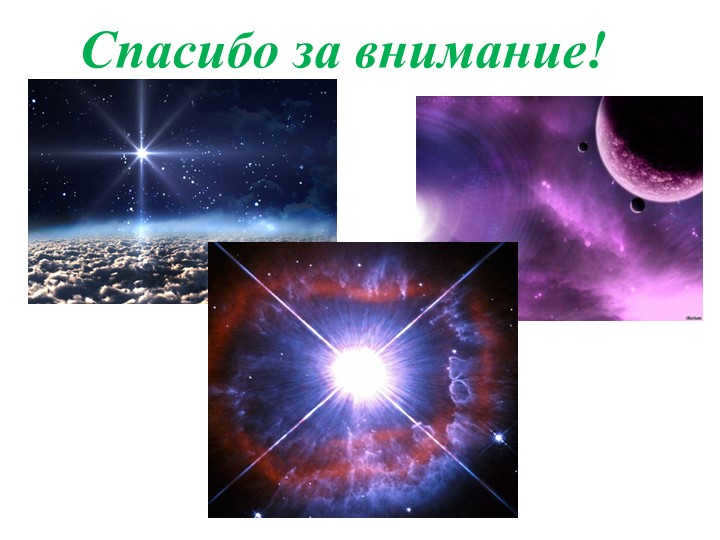
Summary of the Document:
This content is designed for usage in global lessons on the topic of the “Solar System.” The slides provide a concise and comprehensible description of the stars and constellations within the solar system. Definitions of the terms “What is a star” and “What is a constellation” are provided, along with a classification of stars by their types.
Worksheets and educational materials for teachers and instructors
Over 10,000 educational resources for both classroom and at-home learning
Online courses for educators
Evgeny Yamburg Pavel Severinets
Revolutionary changes in the upcoming academic year of 2023
Accessible session for educators and administrators from educational institutions
Discover resources for every lesson by selecting your subject (category), grade level, textbook, and topic:
Over 6 million materials available in the database
You may find these courses interesting:
- Retraining course in “Marketing: teaching theory and methodology in an educational institution”
- Retraining course in “Clinical psychology: teaching theory and methodology in an educational institution”
- Professional development course in “Organization of student internships in accordance with the requirements of FSES of legal training directions”
- Advanced training course in “Organization of student internships in accordance with the requirements of the Federal State Standard of Medical Education”
- Advanced training course in “Legal regulation of advertising and PR activities”
- Training course “Theory and Methodology of Teaching Ecology and Basics of Life Safety in Educational Organizations”
- Course “Norming Environmental Quality” for professional development
- Course “Insurance and Actuarial Calculations” for advanced training
- Course “Sources of Finance” for advanced training
- Training course “Technical Support for Installation and Operation of Information and Communication Systems for Clients”
- Training course “Corporate Culture as a Factor of Efficiency in Modern Organizations”
- Training course “Storage and Preservation of Museum Objects and Collections in Museums of All Kinds”
- Training program “Implementation of a system for accounting and monitoring the management of production and consumption waste”.
- Training program “Organizing and controlling the process of providing credit brokerage services”.
- Training program “Strategic management of remote information and reference services”.
Post a Comment
If you believe that the content is infringing on copyrights or should be removed from the website for any other reason, you have the option to file a complaint about the material. Remove Material
Author Information
- Member Since: 4 years and 9 months ago
- Followers: 0
- Total Views: 17072
- Total Posts: 17
81 minutes
39 minutes
59 minutes
Gift Vouchers
The users who have uploaded the materials on the site are responsible for resolving any conflicts regarding the materials and their content. Nevertheless, the site’s administration is prepared to offer full assistance in addressing any concerns related to the site’s operation and content. If you come across any unauthorized use of materials on this site, kindly notify the site’s administration via the provided feedback form.
All content published on this website is either produced by the website’s authors or submitted by its users, and is provided for informational purposes only. The copyrights for these materials belong to their respective creators. Copying any part or the entirety of the website’s content without written permission from the site’s administration is strictly prohibited! Please note that the opinions expressed by the administration may not necessarily align with those of the authors.

On a cloudless night, one can observe numerous glittering dots in the sky, intriguing with their enigmatic allure… They seem to be so far away… Apart from 2400 distinct stars, one can also spot a delicate silver band in the sky – the magnificent Milky Way. Planets can be likened to Earth’s siblings, whereas stars can be perceived as the sun’s siblings. However, we perceive stars in various manners. Some shine with greater intensity, while others are barely discernible. Their brilliance is determined by their size. Scientists classify stars into eighteen magnitudes. For instance, a star of the first magnitude is precisely 2.512 times larger than a star of the second magnitude. Certain stars even surpass the Sun in both luminosity and size, while others fall short in comparison.
Stars are positioned at such a great distance from us that it would take more than a human lifetime to track their relative movements. From our perspective, they appear to be “stationary” in the sky, which is why they are referred to as fixed stars. Consequently, these distant fixed stars create distinct patterns known as constellations. During ancient times in Egypt, Greece, and Babylon, the movement of stars was not perceptible, resulting in constellations appearing nearly identical. Our ancestors observed these constellations, identified patterns and similarities with the world around them, and named them after heroes, animals, and other entities that shared these resemblances. While some constellations, like Scorpio and Leo, have names that accurately describe their shape, the same cannot be said for others.
Currently, we have a total of 88 constellations. These constellations have been passed down to us from ancient Greece. However, the stars were believed to form entirely different shapes by the Indians, Egyptians, Chinese, and peoples of the southern seas, unlike the constellations we know today.


Star designations
Not all stars possess designated names. Only the most brilliant and sizable stars are bestowed with names. Stars that are less luminous are assigned ordinal numbers in lieu of names. Planets, on the other hand, are denominated after Roman deities (Mercury, Mars, Venus, etc.). Fixed stars are assigned Latin, Arabic, or Greek designations. For instance, the most radiant fixed star is called Sirius, which signifies “shining.” They are designated using the letters of the Greek alphabet (Alpha, Beta, Gamma, etc.) in accordance with their brightness.

Are constellations subject to change?
Undoubtedly, stars are not stationary, but even over the course of thousands of years, their movement is imperceptible to the human eye. This means that many constellations will remain unchanged to us, just as they appeared countless years ago. However, it is highly unlikely that in 100,000 years, anyone will believe that the Big Dipper constellation, for instance, appeared exactly as we perceive it today.
Stars and constellations have always intrigued individuals since ancient times. They have been meticulously studied and scrutinized in an attempt to comprehend their essence. The enchanting allure of the night sky is truly captivating. The fascination with celestial entities has persisted throughout the centuries.
They claim that the stars are the building blocks of everything. And one cannot argue with that. This hypothesis is substantiated by the Sun, as it is the one that aids in sustaining life on our planet. Scientists continuously discover new star formations, and now it is possible to purchase an actual star in the sky and give it a name.
This article will present 10 fascinating facts about stars and constellations for kids: formations like Aries, Virgo, and other colossal ones. It will also provide guidance on navigating the sky and various other tips. Perhaps you too will develop a desire to have your own shimmering star above your head.
10. Stars have a uniform composition
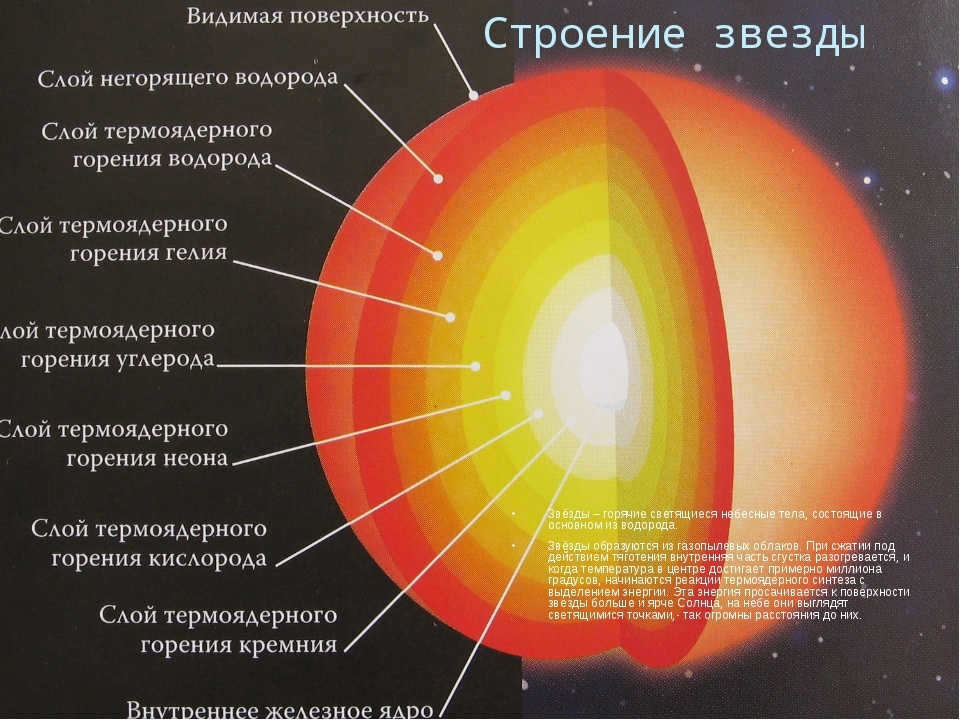
It is an astonishing truth that has been scientifically verified for a long time. Irrespective of their size, color, or distance, all stars have the same composition. All stars are formed in a similar manner, resulting in a composition that consists of 74% hydrogen and 25% helium (with the remaining 1% being other elements). When the gas condenses into a sphere, some of the hydrogen undergoes a transformation into helium.
9. Paired stars exist
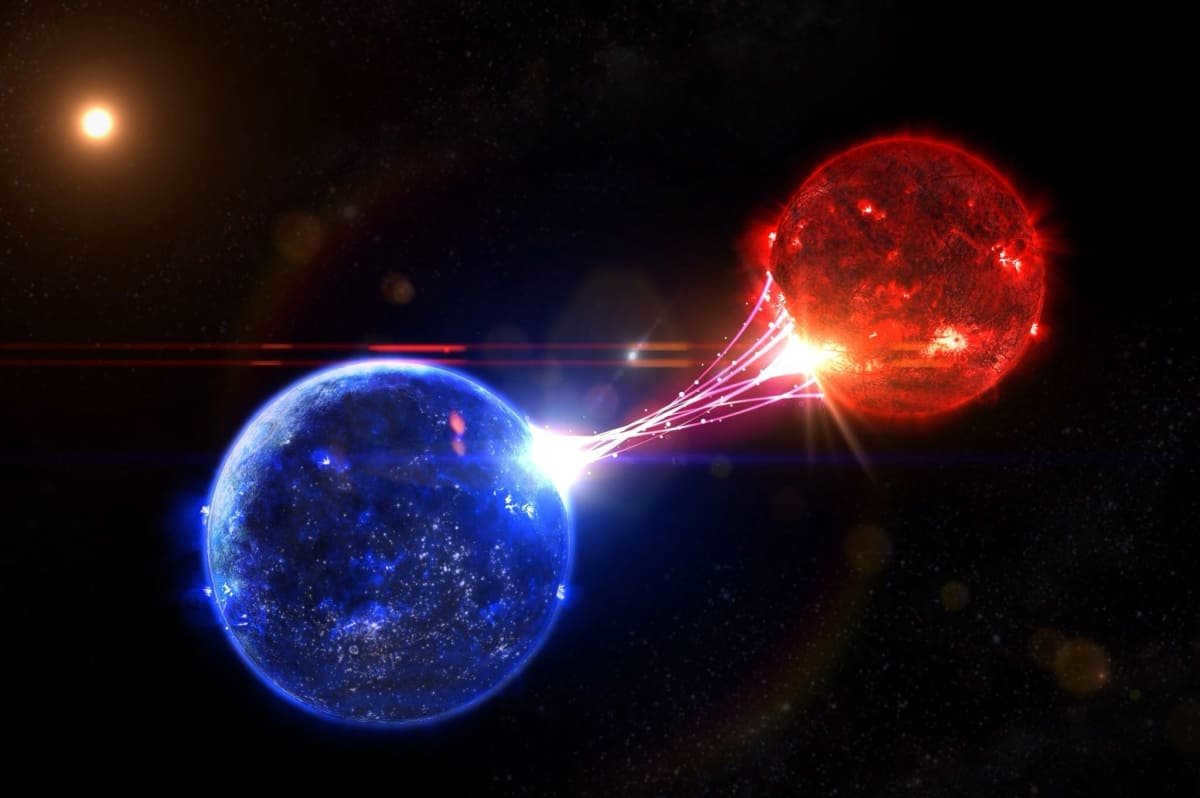
This occurrence is quite common. Double stars are the most commonly referred to as paired stars. These pairs of stars orbit around a central point due to the force of gravity acting upon them. There are instances where scientists observe a pair of stars through a telescope and find that they are very close in proximity but have no similarities.
At times, these stars are identical in every aspect, while in other cases, they are completely different. For instance, it could be a large, bright, and cool star paired with a smaller, hot, and blue companion. These pairs cannot be seen without the aid of a telescope.
8. The twinkle of stars is caused by the Earth’s atmosphere

The twinkling of stars is not caused by the stars themselves, but rather by the refraction of light rays. When light passes through the Earth’s atmosphere, it undergoes various refractions. However, if you observe a very distant star through a telescope, it will not twinkle.
Astronauts who venture into outer space describe a sky filled with celestial bodies that emit a steady, bright light.
The atmosphere on our planet is in constant motion. Fluctuating temperatures cause light to refract in different directions. This creates the mesmerizing twinkling effect when light passes from a denser atmosphere to a less dense one.
Today, astronomy distinguishes 88 constellations
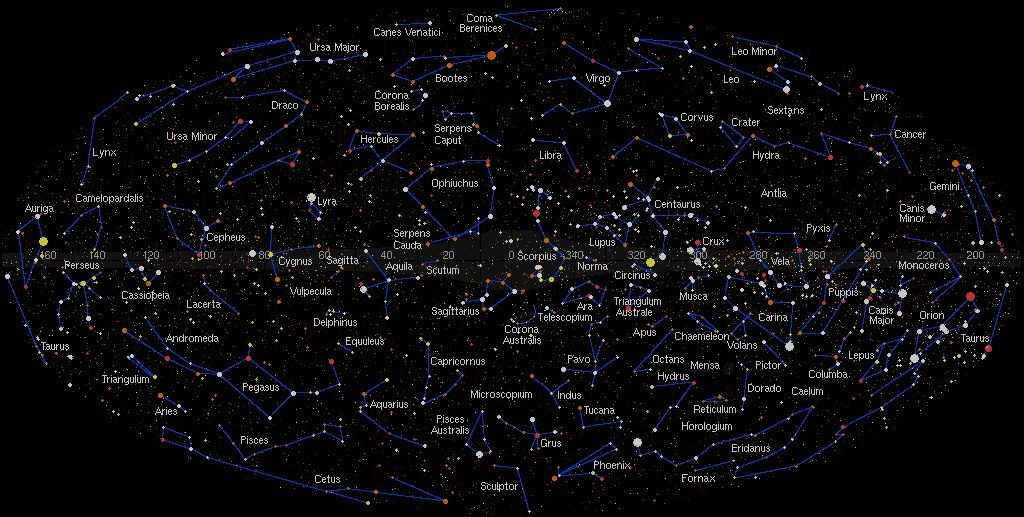
Scientists are currently aware of 88 constellations. Many of these constellations have gained popularity and are easily recognizable. In ancient times, people would connect the stars together to form “patterns” and assign them various names. These constellations would then inspire legends and myths that were passed down from generation to generation.
Constellations like the Big and Little Bears, Orion, and Cassiopeia are well-known and can be observed by both astronomers and ordinary people. Popular constellations are easily visible in the sky, especially during the summer season.
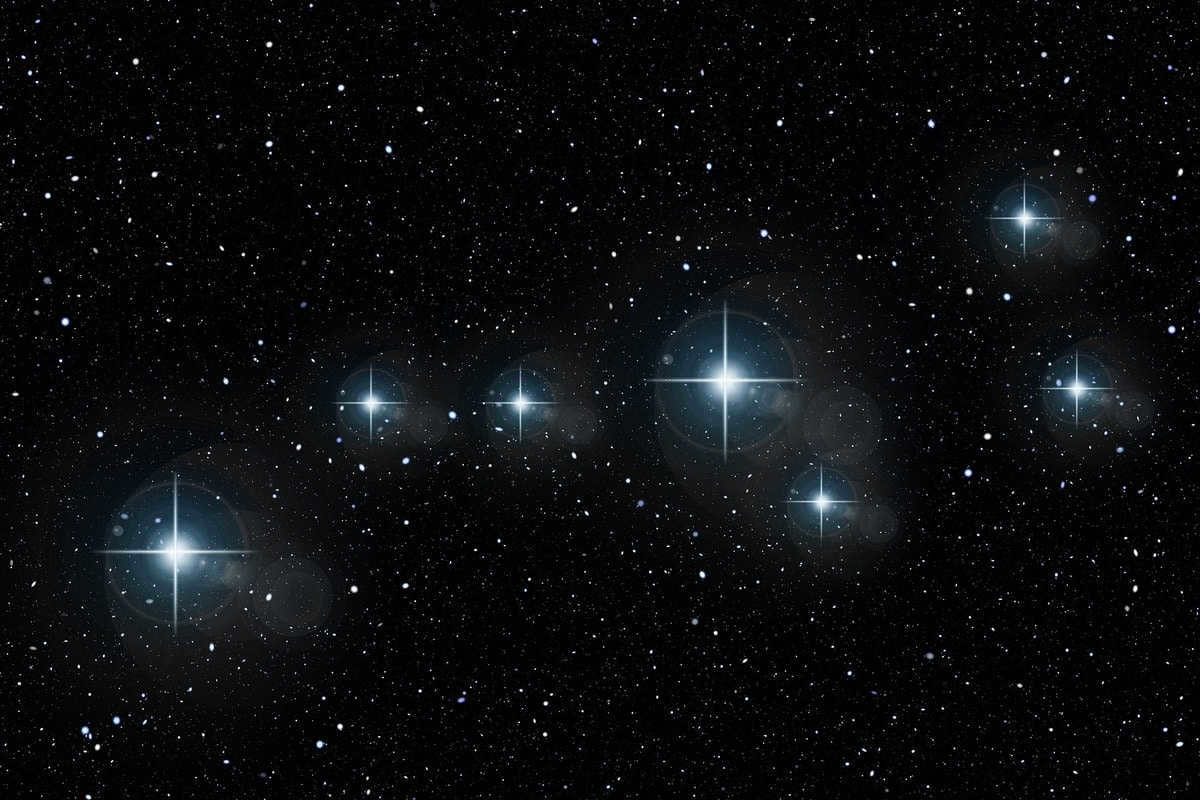
Homer mentions the Big Dipper in one of the most well-known songs from The Odyssey. The poet himself referred to this constellation as – “a constellation that never submerges its stars beneath the waves of the sea.”.
Scholars continue to be amazed by the accuracy of Homer’s works, and his songs are regarded as the primary source of information about ancient Greece. In that region, the Great Bear constellation is seen as a constellation that sets, as its stars nearly reach the Aegean and Ionian Seas.
5. The constellation of Orion was revered by the people of ancient Egypt

The Egyptians had a comprehensive approach to studying the celestial sky and made efforts to pass on their accumulated astronomical knowledge to future generations. They held the constellation of Orion in high regard, considering it not only the most beautiful but also worthy of honor. In ancient legends, the constellation received different names depending on its cyclic trajectory.
The Egyptians revered Orion because when the constellation reached its highest point in the sky, the Nile River would flood in Egypt. This marked the beginning of nature’s rebirth, with plants, leaves, and animals emerging to receive the life-giving moisture and the energy of the sun.
4. Pistol Star holds the record as the galaxy’s hottest and most brilliant star

Pistol Star has rightfully earned the title of the hottest and most luminous star. Its form is maintained solely by the force of gravity. It is also renowned for its brilliant blue hue.
The mass of Pistol Star is astonishing, nearly equivalent to thirty times that of the Sun. However, even with this substantial mass, it is not the largest star in the galaxy.
3. The largest known star is VY of the Big Dog.


Scientists have extensive knowledge about numerous stars, and the most massive star is VY of the Big Dog constellation. It is approximately 1800 times larger than the Sun, although some reports suggest it could be 2200 times larger.
There are numerous ongoing debates surrounding this hypergiant. Despite its immense size, VY’s mass is only 17 times that of the Sun, indicating an unusually low density. However, it has been established that VY might not be the largest star in existence. Other galaxies might contain even larger stars, but current telescope technology is not yet powerful enough to detect them.
2. The sky is home to the largest constellation, Hydra
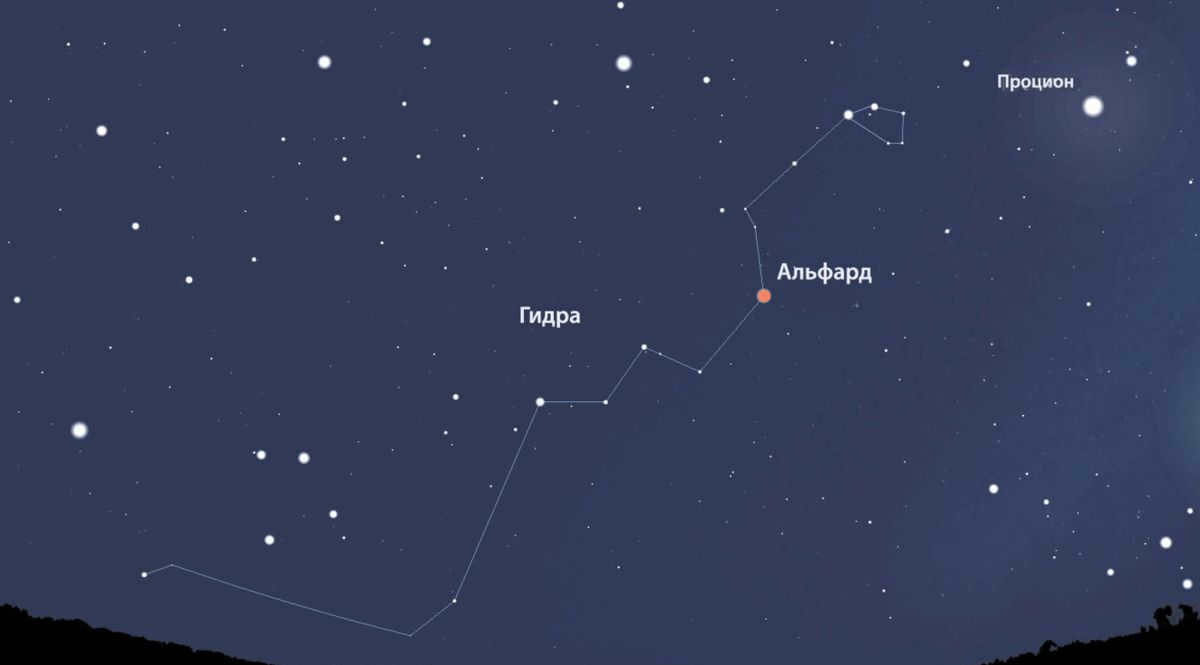
Out of all the constellations currently known, Hydra holds the distinction of being the largest. This constellation encompasses nearly 4% of the entire sky. Its name, the Water Snake, is fitting as it does indeed coil around numerous other stars.
Like many other constellations, Hydra has its own share of myths and legends. One such legend states that Hydra is a monstrous creature with multiple heads that was ultimately slain by Hercules. However, despite its immense size, this constellation is not easily recognizable. It does not stand out among the surrounding stars and is comprised of faint celestial bodies.
1. The sky presents various constellations throughout the year

Day and night, summer and winter, we can observe the magnificent starry sky. As we all know, the Earth not only rotates around its axis but also orbits the Sun, causing the positions of the constellations to change, allowing us to discover new ones.
Amongst the ever-changing celestial patterns, Polaris remains steadfast, serving as a convenient starting point for stargazing. It sits just 1° from the north pole, ensuring it remains in place throughout the year. Unlike Polaris, all the other stars gracefully traverse the sky along their usual path, much like the Sun.








